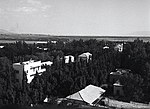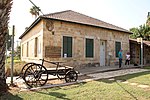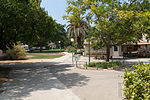Naharayim (Hebrew: נַהֲרַיִים literally "Two rivers"), historically the Jisr Majami area (Arabic: جسر المجامع literally "Meeting bridge" area), is the area where the Yarmouk River flows into the Jordan River. It was the site of the "First Jordan Hydro-Electric Power House", constructed between 1927–33, and located near an ancient Roman bridge known as Jisr Majami. The site was named by the Palestine Electric Company which assigned "proper names" to the "different quarters of our Jordan Works", one of these being the "works as a whole including the labour camp" to be called "Naharaim", and another being the site of the "Power House and the adjoining staff quarters, offices" to be called Tel Or (Hebrew: תל אור - Hill of Light). Most of the plant was situated in the Emirate of Transjordan and stretched from the northern canal near the Ashdot Ya'akov in Northern Mandatory Palestine to the Jisr el-Majami in the south.
The plant, now no longer in use, was built by Pinhas Rutenberg. It produced much of the energy consumed in Mandatory Palestine, until the 1948 Palestine war. The channels and dams built for the power plant, together with the two rivers, formed a man-made island. The residential area is known today as Qaryet Jisr Al-Majame (Arabic: قرية جسر المجامع - Community Bridge Village).
The 1994 Israel–Jordan peace treaty recognized part of the area – known as the Naharayim/Baqura Area in the treaty or, according to the map annexed to the treaty and authenticated by both Israel and Jordan, the Baqura/Naharayim area – to be under Jordanian sovereignty, but leased Israeli landowners freedom of entry. The 25-year renewable lease ended in 2019. The Jordanian government announced its intention to end the lease; the treaty gives Jordan the right to do so only on one condition – that one year prior notice is given, which coincided with the announcement in October 2018. Jordan reclaimed Al-Baqoura in November 2019 after a one-year notice of termination submitted by the Jordanian government.











